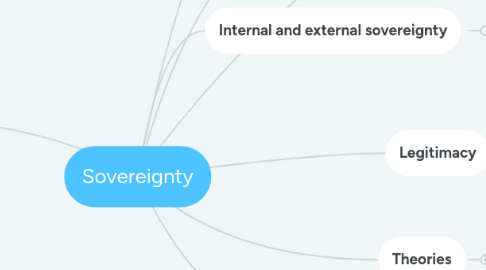
1. add info
1.1. Who is sovereign: States, by exercising control over what happens inside theie borders.
1.2. Principals are the non- intervation and self-determination.
1.3. Goverment: The system and the people within that admisinstrate the state.
2. Within the borders, it gives you autonomy, have a self-government and independence
3. Legitimacy
3.1. Sovereignty in a state is dependent on other state recognizing him as a state.
3.1.1. Groups like the islamic state can call theselves states, but without recognition, they can´t be consider a sovereign state.
3.1.1.1. Soverign state should have
3.1.1.1.1. effective government
3.1.1.1.2. A defined territory and borders
3.1.1.1.3. The capacity and legitimacy to enter into relations with other states
3.1.1.1.4. A permanent population
4. recognize statehood
4.1. The United Nations is the main international body who agrees the legitimacy of state borders and makes ruling on borders that are contested. At an international level, the resolutions of the UN security council and the decisions of the Internationa Court of Justice.
4.1.1. Some examples are
4.1.1.1. The Kosovo independence from the Republic of Serbia.
4.1.1.2. China wants to expand its territory in the sea and doesn´t recognize the ICJ. In response the UN has sent "Freedom of navigation" patrols. Although China claims the territory as it´s own, the UN recognize it as international waters.
4.1.1.3. Kashmir, is the border between India and Pakistan, they both recognise the territory as its own, but the UN agreed a temporary border between the two.
4.2. At a national level, states hold a referrendum, in which the population decides independence.
4.2.1. The annexed of Crimea, that although held a referrendum it was found illegitimate by the UN, Russia had to vetoed to avoid the unvalidating of the referrendum
5. Is state sovereignty being eroded?
5.1. Many think globalization and multination organizations, as well as terrorist networks are weakening state sovereignty
5.2. For realists, states are the most important actor in global politics , while in liberalism, states still exist but they cooperate to maximize their security and prosperity by pooling rather than defending.
5.2.1. Claims and counterclaims.
5.2.1.1. Borders are decreasing in significance, because states are dealing with issues that pass borders.
5.2.1.1.1. Borders define independent states, states still decide their own economic and political policies and national identity still matters.
5.2.1.2. Economic globalization is reducing the importance of economy in states, there is increasing global trade and in ocassions, corporations can change economic policies of a state.
5.2.1.2.1. Economic policy is still decided by nations. Although corporations are powerful, they can´t act in a crisis, where states can.
5.2.1.3. IGOs are becoming more powerful. They have supranational powers and can make laws to their member states.
5.2.1.3.1. States can choose to be part os IGOs. Their us no world governing body with the power to act above the nation. state level. Many IGOs allow states to protect core national interest.
5.2.1.4. International conventions no longer regard state sovereignty as absolute.
5.2.1.4.1. States can still abuse human rights. Decisions about external intervention are based on international agreement.
5.2.1.5. Non-state actors are frequently challenging state sovereignty.
5.2.1.5.1. While is it true, there is not in all states, only in a part of the world. Also said attacks have been repeled by military action.
6. Theories
6.1. Liberals
6.1.1. Sovereignty is an important but not exclusive principal in international political relations. Other states can punish if they commit crimes within their borders.
6.2. Realists
6.2.1. Realists are capable of changing their sovereginty point of view, only to accomplish their self interest. in one hand, realist believes that the most important actors in global politics are defined by ststes within sovereign state boundaries. Realist can take military action against dictatorships, only if their interests are met in them.
7. Organization of states
7.1. Sovereignty is divided in models of state. Each distributes power differently and ensures accountability. In no democratic states, goverments need to use authoritarian means to control their territory.
7.1.1. Federal states
7.1.1.1. A goverment in the capital city that controls some policies. The are also sub-national level goverments who have the power to enforce their laes in their states.
7.1.2. Unitary states
7.1.2.1. Most decisions are decided by a national legislature sucha as a parliament or an assembly. The central goverment posseses all the power.
7.1.3. Fragile states
7.1.3.1. Democratic or undemocratic. The internal power of the state is weak. Mainly because of the goverment capabilities in its borders.
7.1.4. Authoritarian states
7.1.4.1. Where there is no democracy, the government can rule as pleased without a challenge. Leaders stay in power as long as they wish, or until there is a military coup, foreign intervention or public uprising.
7.1.5. Monarchy
7.1.5.1. A royal family, unleceted, but given power thorugh generations in the sema family. Some are just a role or symbol of power, while others have big impact in politics.
7.1.6. Theocracy
7.1.6.1. Goverment by religion in the state. An example can be the Islamic Republic, ran by its Supreme Leader who makes decisions on internal politics.
